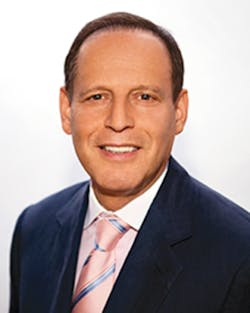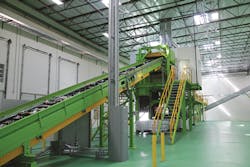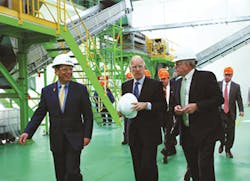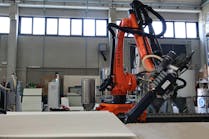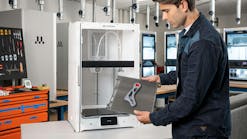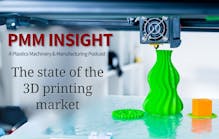
Leon Farahnik, a longtime leader in the plastics industry, is no stranger to change. He worked in his father's plastics extrusion business in Iran, then immigrated with his family to the U.S. after the Iranian Revolution in 1979. In the U.S., he has proved himself a savvy businessman, becoming a major player in plastics extrusion and thermoforming.
Along the way, he has been an innovator in post-consumer plastics recycling, starting an in-plant recycling facility as part of his film extrusion business in 2005. In 2012, he opened CarbonLite Industries LLC, one of the largest PET bottle recycling facilities in the country, diverting more than 2 billion PET bottles a year from landfills and making them into food-grade resin. Making a profitable business out of recycled PET bottles has been his toughest career challenge, he said, but a worthy one because it helps to preserve the environment for future generations. He recently spoke with Plastics Machinery Magazine senior correspondent John DeGaspari.
Tell us about your early years. How did you get involved in the plastics industry in the U.S.?
Farahnik: I have been involved in the [U.S.] plastics industry since 1979. We were one of the first companies to manufacture the plastic grocery sacks.
What led you to choosing the plastics industry to work in?
Farahnik: My father was already in the plastics business in Iran. That is how I got involved, and it stayed with me. And of course, with the revolution that took place in Iran, I moved here to the U.S., and started manufacturing here in the U.S. [My father] came eight years later and was not involved in the business. [In Iran] he was heavily involved in film extrusion. Of course, at that time, with the revolution, all of the facilities were taken over by the government. I worked in my father's factory since I was 15 years old. I went to the first K show in Germany when I was 9 years old and I have not missed a K show since.
What about your education; do you have an engineering background?
Farahnik: No, I have a business administration background; no engineering, just business. I went to USC [University of Southern California in Los Angeles] and San Diego State University.
What sparked your interest in plastics recycling? Was there a "eureka" moment when you said, this is the business for me?
Farahnik: There was no eureka moment. All plastics companies have in-house recycling. I don't know of a plastics manufacturer that doesn't have a grinder or something to reuse their material.
Post-consumer [scrap] is a totally different world. I am a firm believer that the future of the plastics industry [depends on] recycling, because nothing biodegrades in landfills, where you don't have oxygen, air and sunlight. That's why I built this facility to take post-consumer bottles, beverage bottles and turn them into post-consumer food-grade resin that is used by companies like Nestlé and Pepsi.
You have been involved in several plastics processing businesses since 1979. What did you learn about recycling in your earlier experiences?
Farahnik: The first recycling facility that would recycle used grocery sacks was a company I owned called Hilex [Hilex Poly Co. LLC]. We built a facility specifically to take in used bags and transform them back into new bags. We had containers outside the grocery stores, and we asked people that if they were not using their plastic bag, to please put it back into the bins and it would be recycled. You go through a complete process of washing, cleaning, and grinding it down into smaller film particles; then transform it back into making bags. We did that in 2005.
I got involved in thermoforming packaging [with the acquisition of PWP Industries in 2001, sold to Pactiv LLC in 2010]. When I owned PWP, we had a post-consumer recycling facility there as well for thermoformed packaging. In 2010, I decided to enter recycling of PET bottles.
What process do you use to select the equipment?
Farahnik: Experience. We go through a learning curve, knowing who does what, and visiting a lot of recycling facilities in Europe and around the world. When you are in the plastics business, you end up knowing a lot about the industry.
How did you select the equipment in the recycling line?
Farahnik: The equipment is mostly European. Europe is way ahead of us in recycling and in environmental issues. We chose Bezner in Germany for bale breaking; the washing line is from Sorema in Italy; our pelletizing line is from Erema in Austria. Those are our major suppliers.
What's the quality of the plastic scrap that you collect?
Farahnik: It comes from the deposit centers, so it has already been separated. Most of it is PET, but of course we end up with some aluminum cans in the bales, and some PVC or HDPE or coextruded bottles.
Explain the technology for separating the PET from non-PET.
Farahnik: You have bottle sorting and then you have flake sorting; you have to separate the bottles and then you have to go through and separate your flakes as well. The sorting comes from S+S [S+S Separation and Sorting Technology GmbH, now Sesotec GmbH], and we use the Sortex system [supplied by Buhler Sortex Ltd.]
What happens after the sorting and cleaning stages?
Farahnik: It goes through heating reactors [supplied by Erema]. You decontaminate the product and then you melt it down.
You have a very large facility; are these lines customized?
Farahnik: It is customized to a point. I like the idea of a more open plant because you can control things better. I like to follow a line from the time we break up the bales all the way to the recycled resin; and it's open so people can work and do maintenance work.
Do you test the materials in-house for your customers?
Farahnik: We have a very high-tech laboratory in our facility, which is required by the big beverage companies. We test everything here.
Do you have expansion plans?
Farahnik: We are expanding into Dallas. We are hoping to be in production in the first quarter of next year. It will encompass conveying and sorting equipment from BHS [Bulk Handling Systems], washing equipment from Amut, and Erema [for decontamination and pelletizing]. This will be for PET recycling; we will be supplying Nestlé with resin for their production of water bottles.
Do you have a wish list for improvements in technology?
Farahnik: My wish list is very simple. The labeling sleeves around the bottles are a headache. They are polypropylene, and their removal is not easy. Also, if there were no glue used on labels, it would drastically cut costs of manufacturing and become a lot easier … to wash the bottles, because the main wash we do and the chemicals we use is to wash the glue off the bottle. If there was no glue used at all, and it was shrink-wrapped labels, that would very much help recycling. Also, I wish there was no PVC used for bottles; PVC creates a lot of headaches for us as well.
What were the technical challenges in starting your post-consumer PET recycling business?
Farahnik: I have built 22 different facilities in my lifetime for manufacturing plastics, and the most difficult task I ever had has been building a [post-consumer] recycling facility. Every bale of product you bring in has a different character. It's not like using virgin material that is very consistent. You are dealing with a product that changes from bale to bale and you have to have a facility that can cope with the changes.
We learn something about recycling every day, so it's a nonstop learning curve. For every 100 pounds that we get in, we end up with 70 pounds. We pretty much lose 30 pounds to the dirt, the caps, the labels, and the water and the liquid residue. And we lose about 30 percent, and that is in California, because California has a very good waste stream.
It sounds like a risky business.
Farahnik: It's a very high-risk business. If you don't have the financial stability to get you through the learning curve, then you will not make it.
How would you like to be remembered, personally or professionally?
Farahnik: You work very hard, on average I worked, and still do, an average of 12 to 14 hours a day.
I have dedicated a lot of my life to plastics, to plastics recycling. In general, all of the facilities that I built are still in operation. I have created thousands of jobs in the plastics industry. And came up with some good ideas and have great people.

